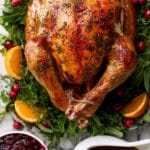Description
This juicy roast turkey recipe uses a dry brine salt rub followed by a two-step roasting process to yield a tender, flavorful bird with crispy skin. The turkey is brined for 48 hours for deep seasoning, then roasted upside down to keep the breast moist before finishing upright with garlic herb butter bastes. The result is a perfectly cooked turkey ideal for holiday celebrations, served with a rich homemade gravy made from the pan drippings, garlic, and herbs.
Ingredients
Scale
Turkey and Dry Brine Salt Rub
- 10 lb / 5 kg whole turkey, thawed (plain, not pre-brined)
- 2 1/2 tbsp kosher salt / cooking salt
- 2 tsp dried thyme or other dried herb of choice
- 1 tsp paprika (sweet or ordinary)
- 1 tsp garlic powder (optional)
- 1/2 tsp black pepper
For Roasting
- 2 heads garlic, halved horizontally (4 halves)
- 1 onion, halved with skin on (brown, yellow, or white)
- 2 small bunches mixed fresh herbs (sage, rosemary, thyme, parsley) – for stuffing and roasting pan
- 10 tbsp (150g) unsalted butter, melted
- 1 tbsp total sage, rosemary, and thyme, finely chopped (equal parts)
- 3 garlic cloves, minced
- 1 1/2 cups dry white wine (such as sauvignon blanc or pinot gris) or water
- Salt and pepper, to taste
For Gravy (~4 cups / 1L)
- 4 cups low sodium chicken broth / stock
- 5 tbsp all-purpose flour
- Salt and pepper, to taste
Instructions
- Dry Brining Preparation: Mix together kosher salt, dried thyme, paprika, garlic powder, and black pepper to make the salt rub. Pat the turkey dry inside and out with paper towels and remove giblets.
- Apply Salt Rub: Sprinkle 1 tsp of the rub inside the turkey cavity and spread with your hand. Turn the turkey upside down and rub 1 tsp of the rub on the underside. Turn upright and rub remaining salt mix all over the turkey, focusing on the breast and under the skin where possible.
- Wrap for Brining: Wrap the turkey tightly mummy-style in cling wrap or place inside a large resealable bag. Place turkey upside down in a baking pan.
- Refrigerate for Brining: Refrigerate for 48 hours, flipping the turkey to right side up after 24 hours. After 48 hours, unwrap the turkey, pat dry if skin is wet, and let sit at room temperature for 30 minutes before roasting.
- Prepare for Roasting: Preheat oven to 220°C/425°F (200°C fan forced). Place halved onions and garlic heads in a roasting pan and place a roasting rack on top or use a homemade foil ring if no rack.
- Stuff and Season Turkey: Stuff the cavity with 1 bunch of fresh herbs, 2 garlic halves, and 3 tbsp (45g) of softened butter. Tie drumsticks together with kitchen twine, twist wings on top, and place turkey upside down on the rack. Brush with melted butter and season lightly with salt and pepper. Pour wine or water into the roasting pan.
- Roast Upside Down: Roast turkey at 220°C (425°F) for 30 minutes to brown the skin.
- Flip and Lower Heat: Using a tea towel, carefully flip the turkey right side up. Reduce oven to 165°C/325°F (150°C fan). Brush with butter and sprinkle with salt and pepper.
- Roast at Lower Temperature: Roast for 45 minutes at 165°C (325°F).
- Prepare Garlic Herb Butter: Mix remaining melted butter with minced garlic and chopped fresh herbs.
- Baste and Finish Roasting: Brush the turkey generously with garlic herb butter and continue roasting for another 30 minutes or until an internal thermometer inserted between breast and leg reads 165°F/75°C. Cover loosely with foil if the skin browns too quickly.
- Rest the Turkey: Remove the turkey from the oven, transfer to a serving plate, loosely cover with foil, and rest for 30 minutes before carving.
- Make Gravy: Place the roasting pan on the stove over medium-high heat. Stir in flour and cook for 2 minutes. Add chicken broth and mash the onion and garlic into the pan using a potato masher. Scrape browned bits off the pan bottom and cook until thickened, 3 to 5 minutes. Strain through a sieve, pressing to extract flavor, and transfer gravy to a serving vessel.
- Serve: Serve turkey carved alongside the homemade gravy and optional cranberry sauce.
Notes
- Ensure the turkey is fully thawed before starting. Thaw in the fridge, allowing 24 hours per 3–4 lbs (1.5–2 kg) of turkey, or thaw more quickly in a sealed bag submerged in cold water, changing water every 30 minutes.
- Adjust salt quantity depending on salt type: use 1 tbsp kosher salt per 2 kg turkey. For fine table salt, reduce by 1/4 tsp per tablespoon.
- Use fresh herbs for aroma and flavor; dried herbs can be used but add them later in the cooking process to prevent burning.
- White wine should be dry and not sweet or heavily oaked.
- Giblets can be used to make the gravy; typically neck, heart, and liver are included.
- Wrapping turkey in cling wrap keeps the brine consistently in contact with the skin for better seasoning.
- Brining for 48 hours is ideal; 24 hours is better than nothing; 72 hours gives more seasoning; beyond 72 hours shows minimal additional benefit.
- If no roasting rack, create one by rolling a thick foil rope into a large ring to elevate the turkey off the pan base and onion halves.
- Roasting time guideline: approximately 12 minutes per 500g (1 lb) at 165°C. For a 10 lb turkey, expect 1 hr 45 min to 2 hrs total roasting time.
- Check doneness with a meat thermometer inserted between breast and leg to ensure temperature reaches 165°F/75°C. If unavailable, check that juices run clear when pierced.
- Leftover turkey can be repurposed into soups, pies, or sandwiches like White Turkey Enchilada Soup or Turkey Pot Pie.
Nutrition
- Serving Size: 1/10 of roast turkey (approx. 200g)
- Calories: 350 kcal
- Sugar: 0.5 g
- Sodium: 620 mg
- Fat: 24 g
- Saturated Fat: 9 g
- Unsaturated Fat: 13 g
- Trans Fat: 0.2 g
- Carbohydrates: 2 g
- Fiber: 0.3 g
- Protein: 34 g
- Cholesterol: 110 mg

